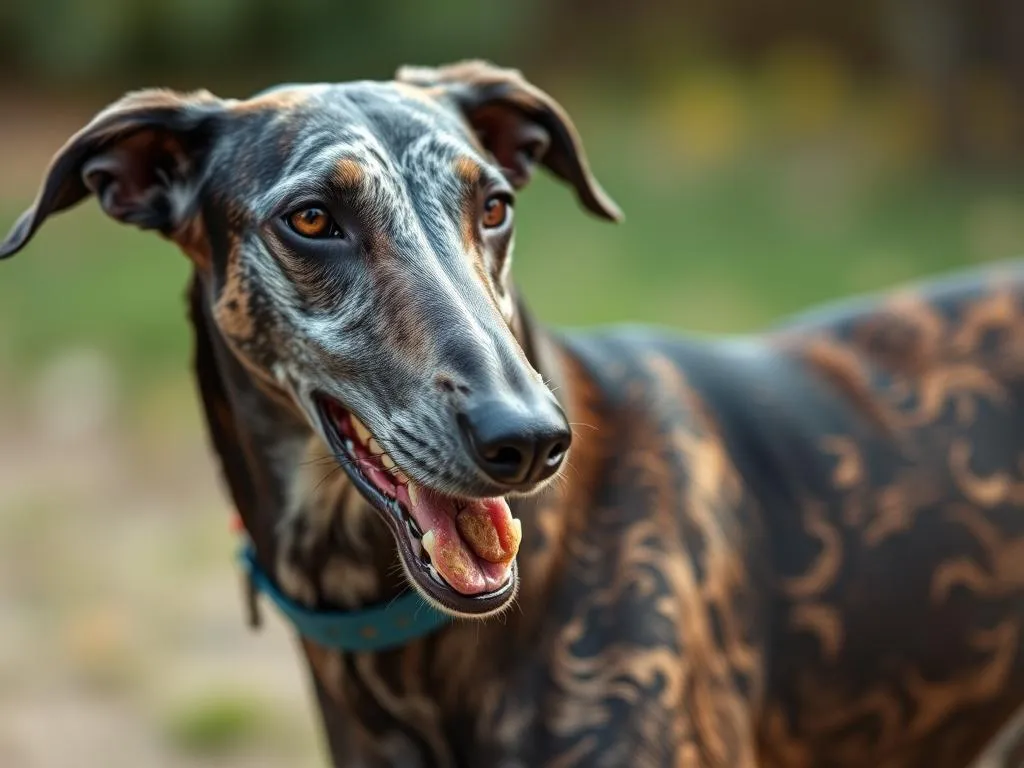
Introduction
Greyhounds are known for their sleek, athletic build and remarkable speed, making them one of the fastest dog breeds. Typically ranging from 60 to 70 pounds, these gentle giants possess a calm temperament, often characterized as affectionate and good-natured. Despite their racing background, they are surprisingly low-energy dogs, often preferring a cozy spot on the couch to any strenuous activity. Understanding their nutritional needs is crucial for their overall health and performance, as proper nutrition plays a significant role in maintaining their energy levels, muscle health, and overall well-being.
Choosing the best dog foods for Greyhounds is essential not only to fuel their bodies but also to prevent health issues associated with improper diets. With their unique dietary requirements, Greyhounds need a diet rich in high-quality proteins, healthy fats, and essential nutrients to thrive.
Understanding Greyhound Nutrition
Nutritional Needs of Greyhounds
Greyhounds have specific nutritional needs that differ from other breeds, primarily due to their unique body composition and energy demands.
- Macronutrients:
- Proteins: Greyhounds require a high-protein diet to support their lean muscle mass and overall health. Look for foods that list high-quality animal proteins, such as chicken, beef, or fish, as the primary ingredient.
- Fats: Healthy fats are crucial for providing energy and supporting skin and coat health. Greyhounds benefit from omega-3 and omega-6 fatty acids, which can help reduce inflammation and improve joint health.
-
Carbohydrates: While Greyhounds don’t need as many carbohydrates as some breeds, complex carbs like sweet potatoes and brown rice can provide a healthy energy source.
-
Micronutrients:
- Essential vitamins and minerals play a vital role in a dog’s health. Greyhounds need adequate amounts of vitamins A, D, E, and B-complex, along with minerals like calcium and phosphorus for bone health and muscle function.
Unique Dietary Considerations
Greyhounds may have sensitivities to certain ingredients commonly found in dog foods, such as fillers or artificial additives. Their digestibility is crucial; therefore, opting for easily digestible formulas can help prevent gastrointestinal issues.
Additionally, the caloric needs of Greyhounds vary based on their age, weight, and activity level. Active Greyhounds require more calories to sustain their energy, while older or less active dogs may need reduced portions to maintain a healthy weight.
Types of Dog Food for Greyhounds
Dry Dog Food (Kibble)
Dry dog food is the most common form of pet nutrition. It offers convenience and can help maintain dental health through the crunching action. However, not all kibbles are created equal.
- Advantages:
- Convenient storage and serving
- Promotes dental health
-
Generally more cost-effective
-
Disadvantages:
- Some lower-quality kibbles may contain fillers or artificial additives that don’t benefit Greyhounds.
Recommended brands include:
– Orijen: Known for high protein content and fresh ingredients.
– Taste of the Wild: Grain-free options with real meat as the first ingredient.
– Blue Buffalo: Offers a variety of formulas, including options for sensitive stomachs.
Wet Dog Food
Wet dog food is another excellent option for Greyhounds, especially for those who may require additional moisture in their diet.
- Benefits:
- Higher moisture content aids in hydration.
- Often more palatable for picky eaters.
Recommended brands include:
– Hill’s Science Diet: Offers balanced nutrition with various flavors.
– Royal Canin: Formulated specifically for Greyhounds, considering their unique dietary needs.
– Wellness CORE: Grain-free and packed with protein.
Raw and Home-Cooked Diets
Feeding a raw diet or preparing home-cooked meals can allow for customization based on a Greyhound’s specific needs.
- Raw Feeding:
- Pros: Natural diet that can lead to improved coat condition and digestion.
-
Cons: Requires careful planning to ensure balanced nutrition and safety from pathogens.
-
Home-Cooked Meals:
- Recipes can include lean meats, vegetables, and grains, but it’s essential to consult with a veterinarian to ensure nutritional balance.
Common Raw Diet Recipe Components
- Proteins: Chicken, beef, or fish
- Vegetables: Carrots, peas, or spinach
- Grains: Brown rice or quinoa
Key Ingredients to Look for in Greyhound Food
Protein Sources
When selecting the best dog foods for Greyhounds, prioritize high-quality animal proteins. Look for brands that list real meat as the first ingredient, such as chicken, beef, or fish. Quality matters more than quantity; therefore, avoid foods with meat by-products or fillers.
Carbohydrates and Fiber
Opt for suitable carbohydrate sources like sweet potatoes, brown rice, and oats. These not only provide energy but also contribute to digestive health.
- Role of Fiber: Adequate fiber can help maintain a healthy digestive tract, which is essential for Greyhound health.
Fats and Omega Fatty Acids
Healthy fats are vital for Greyhounds. Look for foods rich in omega-3 and omega-6 fatty acids to support skin and coat health and reduce inflammation. Good sources include fish oil and flaxseed.
Additives and Supplements
- Probiotics: Beneficial for digestive health, especially for Greyhounds prone to tummy troubles.
- Joint Supplements: Important for active Greyhounds, particularly those involved in agility or racing, to support joint health and mobility.
Common Nutritional Issues in Greyhounds
Weight Management
Greyhounds are at risk of obesity, which can lead to various health issues. Maintaining a healthy weight is crucial.
- Tips for Weight Management:
- Monitor food intake and adjust portions based on activity level.
- Incorporate regular exercise and playtime.
Allergies and Food Sensitivities
Some Greyhounds may develop allergies or food sensitivities, often to common ingredients like grains or certain proteins.
- Signs of Food Sensitivities:
- Itchy skin, gastrointestinal upset, or ear infections.
Digestive Health
Greyhounds can experience digestive issues such as bloating or diarrhea. A balanced diet with high-quality ingredients is essential for gut health.
- Importance of a Balanced Diet: Ensuring that Greyhounds receive a well-rounded diet can help prevent common digestive problems.
Recommended Dog Foods for Greyhounds
Top Commercial Dog Foods
Finding the best dog foods for Greyhounds can be overwhelming due to the variety of options available. Here are some top picks:
- Brand A:
- Overview: Known for high-quality ingredients and a balanced formula.
- Ingredients: Real meat, wholesome grains, and added vitamins and minerals.
-
Benefits: Supports muscle health and energy levels.
-
Brand B:
- Overview: Focuses on grain-free options.
- Ingredients: High-protein sources with no fillers.
-
Benefits: Ideal for Greyhounds with sensitivities.
-
Brand C:
- Overview: Premium option with a focus on holistic nutrition.
- Ingredients: Organic ingredients, superfoods, and joint supplements.
- Benefits: Comprehensive nutrition for active Greyhounds.
Budget-Friendly Options
Quality doesn’t have to break the bank. Here are some affordable brands that still maintain quality:
- Brand D: Offers balanced nutrition at a lower price point, focusing on real meat and essential nutrients.
- Brand E: Known for its value while providing a good balance of protein and carbohydrates.
Premium and Grain-Free Options
For those looking for premium and grain-free options, consider these brands:
- Brand F: Offers a range of grain-free formulas specifically designed for Greyhounds.
- Brand G: Focuses on high-quality proteins and healthy fats, ideal for active dogs.
Feeding Guidelines and Tips
Portion Control
Determining the right serving size for your Greyhound is crucial for maintaining a healthy weight.
- How to Determine Serving Size: Follow the guidelines on the dog food package based on your dog’s weight and activity level. Adjust portions as needed based on their energy expenditure.
Feeding Schedule
Establishing a consistent feeding schedule helps regulate digestion and energy levels.
- Recommended Feeding Routines: Feed adult Greyhounds twice a day, while puppies may require three to four meals to support their growth.
Transitioning to New Foods
When changing your Greyhound’s diet, it’s essential to do so gradually.
- Steps for Transitioning:
- Start by mixing a small portion of the new food with the current food, gradually increasing the new food over a week.
- Monitor for any signs of digestive upset during the transition.
Conclusion
Proper nutrition is fundamental to the health and well-being of Greyhounds. A well-balanced diet tailored to their unique needs can help maintain their energy levels, support muscle health, and prevent various health issues. By choosing the best dog foods for Greyhounds, you can ensure that your furry friend remains happy and healthy for years to come. Always consult with your veterinarian for personalized dietary recommendations to meet your Greyhound’s specific needs.









